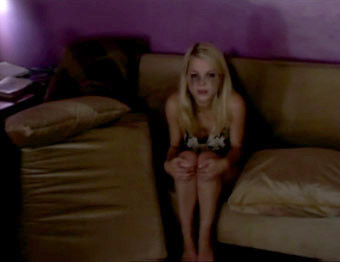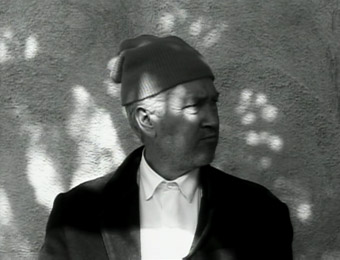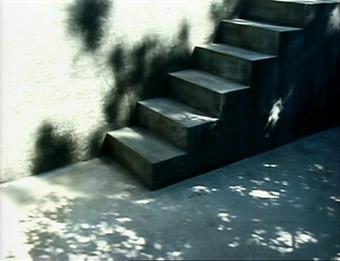|
I'm making an assumption, perhaps rashly, that if you're reading this then you at least know who David Lynch is and have probably seen at least one of his films. If not, I'd be curious to know why. If you are familiar with the director's work but have no time for it then it's probably best we part company now. It's not just that we're Lynch devotees at Outsider, but if you don't get on with his features then you're sure as hell not going to have much fun with the collection here. That doesn't mean they'll instantly delight the fans, either – these are, in effect, pages from Lynch's cinematic sketchbook, works that were previously only available to DavidLynch.com web site members. So if you're looking for polished, fully rounded short film works with a clear, linear narrative then you've definitely come to the wrong place. What you do get are a string of intriguing experiments in sound, vision and atmosphere, and sound really is the constant that links all of the films, particularly in the use of dark and sinister music and unsettling effects. Although this has always been one of the key strengths of Lynch's work, its really brought to the fore here, his ear for the tunes and noises of nightmares turning even a brightly innocent home movie into a troubling horror story.
I'll confess that despite my long-standing enthusiasm for Lynch's cinema, I never got round to becoming a member of his web site, put off in its early days by a subscription fee at a time when I was struggling to fund my internet connection and unable to purchase a remastered Eraserhead DVD that was only available to members with American addresses. Watching the films and listening to Lynch's introductions and the Q&A that follows, I thus couldn't shake the nagging feeling that I was an outsider who'd missed an opportunity to become part of the director's self-formed and clearly close-knit artistic community.
Each of the films is preceded by a brief introduction by Lynch himself and the running times given reflect that.

The Darkened Room (11:51)
A short film example of the twin story structure employed in Lost Highway and Mulholland Drive, with a second half that's as laced with inexplicable dread as either of them. The first part consists of self-shot video by Tokyo resident Etsuko Shikata, who shows us the view through her window and her kitchen sink and talks about the consumption of bananas, which itself becomes the basis for a brief low-key art/rap/dance performance. It's when Etsuko talks about a friend who is located in the room of the title that we move very much into Lynch territory, as the camera lingers on a girl (Jordan Ladd, who played Terri in Inland Empire) hunched on a sofa in a darkened room, her eyes red and streaked with make-up from crying, the soundtrack a menacing blend of deep bass industrial rhythm and off-key electronic chords. She is soon joined by another woman (Cerina Vincent), who talks down to her with calm superiority in language that abstractly alludes to the girl's weaknesses and failings without getting too specific. What may well be a riff on familial abuse ends at the very moment that clarification is promised.
Boat (8:15)
If you're looking for a demonstration of the crucial role sound plays in how a film is read by an audience then this is your boy. What looks like – largely because it is – innocent home movie footage of Big Dave and his boat is transformed by the soundtrack into a nightmare journey into the abyss, a blend of supremely sinister music and an unsettling narration delivered in disturbed whisper by Emily Stofle, who played Lanni in Inland Empire. Seriously, try watching this without sound first and then again with the volume cranked up and you'll experience two completely different films.
Lamp (23:01)
Not a cinematic experiment in the mode of the other films on the disc, but a home movie record of Lynch putting the final touches to a tall, organic looking lamp of his own design and construction. Although backed by a typically offbeat percussion soundtrack, this is essentially a record of an event hosted by Lynch in the mode of a DIY video, with full instructions provided on how to mix and colour Fix-All (a plaster substitute that he swears by) and the best ways to apply the material to the lamp itself. It does go on a bit, but is certainly interesting for its rare glimpse of Lynch the artist and craftsman at work, though he worryingly recalls Terry-Thomas's fastidious husband in Vault of Horror when he tells us "I keep a really neat shop and that's important. Everything in its place and a place for everything."

Out Yonder: The Neighbor Boy (10:31)
A home-made Lynch comedy, if you can imagine (you probably can't, believe me), in which he and his son, Austin Jack, have a helium voiced conversation in a dialect that may have been drawn from southern speech patterns and whose dialogue is based primarily around the term "bees bein'," which I'm not even going to attempt to explain here. Bizarre activity takes place just out of view of the camera, suggested almost entirely by shadows and sometimes insane sound effects. The story, such as it is, involves the pair being visited by the monstrous neighbourhood boy of the title in search of milk. If you tune into Lynch's surrealistic sense of humour (and repeated viewing does help here), then it really is rather funny.
Industrial Soundscape (13:06)
An animation created by Lynch using Adobe Photoshop and After Effects – technology and software he enthusiastically describes in his intro as "a miracle" – to provide appropriately mechanical visuals to a hypnotic industrial instrumental track that I get the impression was composed by Lynch himself. Neatly done, but looped and unchanging, so what you see in the first thirty seconds is all you get. In visual terms it might have benefited from being expanded on as it progressed, but as a gallery piece accompaniment to the music it's rather effective, and certainly had me experimenting with the software again not long after watching it.
The Bug Crawls (5:07)
Another animation in which the soundtrack and dark monochrome visuals provide a nightmarish aura to a threadbare narrative. A bug crawls slowly onto the roof of the blackest house you'll ever see, then falls off onto its back. Forget the story, its all about the visual texture and the creepy soundtrack.

Intervalometer Experiments (19:04)
Effectively, three time-lapse recordings done on the Sony PD-150 camcorder's built-in intervalometer, which records approximately a quarter of a second at set intervals to produce a slightly stuttering but still effective stop motion sequence. The first is a countryside view observed as it slowly slips into darkness, the last a corner of a glass walled room as it does likewise. Interesting through both are, they are blown out of the creative water by the sequence they sandwich, a visually startling piece in which a stone staircase in sunlight of lithographic harshness is approached by the shadows of trees, which by some miraculous trick of the sun's movement then appear to climb the steps. Genuinely extraordinary, and yes, it does make you want to find your own special spot and explore the process yourself. Typically unsettling soundtracks have been provided for all three pieces.
A tricky call this one, given that the films were initially designed to be streamed on the internet rather than whacked up on a 42" plasma. Adding to the problem is that the films were shot on NTSC DV or DV-CAM and standards converted to PAL. The resulting image quality is thus on the soft side, with detail noticeably fuzzy on some of the films and even soft on Lynch's intros. There are also some intermittence motion glitches resulting from the standards conversion and some visible compression artefacts. Contrast is sound enough, and deliberately cranked up on Out Yonder.
The soundtrack is stereo 2.0 at a higher volume than the DVD average, with particularly distinct separation on Out Yonder. The clarity and range are, as you'd expect, impressive.
David Lynch answers questions from web site members (17:34)
OK, I think this is an extra feature rather than one of the films, but the review disc makes it hard to be certain, a menu-free affair in which all of the content has been slapped onto a single, randomly chaptered track. True to the above title (which was one that, in the absence of menus, I made up), this consists of Lynch's response to questions posed by site members, a couple of whom he knows well enough through chat room discussions to regard as friends. The questions are interesting, and as ever with Lynch the responses are well worth hearing, as we get to find out what his favourite musical theme from his films is, how he approaches scriptwriting, what he thinks of Marilyn Manson and Roy Orbison, and just how much he likes his coffee.
An offbeat and rather intriguing collection of experimental shorts that needs to be seen as just that, and while this inevitably limits this disc's potential audience it's still something of a must for Lynch completists and those of us who've yet to join his online community, for which it serves partly as an extended commercial. Whether such a collection is actually worth the asking price will be very much down to how fond you are of the director's work, but there are a few small gems in here, and despite the slightly below par picture quality I'd certainly find it hard to resist.
|